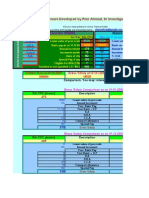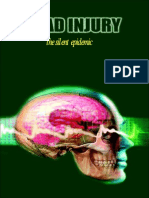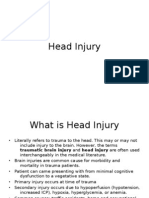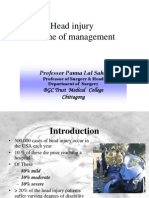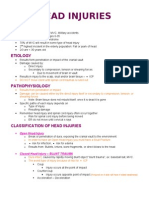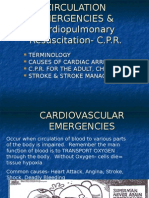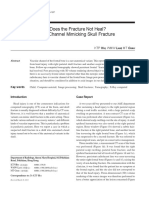Head Injury
Head Injury
Uploaded by
khadzxCopyright:
Available Formats
Head Injury
Head Injury
Uploaded by
khadzxCopyright
Available Formats
Share this document
Did you find this document useful?
Is this content inappropriate?
Copyright:
Available Formats
Head Injury
Head Injury
Uploaded by
khadzxCopyright:
Available Formats
.
*/*HEAD INJURY Simple/Closed Fractures(no communication)
Definition: Trauma to the head causing neurological 1. Linear or fissure fracture.
manifestations. This involves the skull vault and can extend down to
the base of the skull. The linear fracture indicates that
Etiology: most common causes include motor vehicle accidents there has been significant injuries to the head.
(eg, collisions between vehicles, pedestrians struck by motor Management is usually hospital admission and close
vehicles, bicycle accidents), falls, assaults, sports-related observation for any complications.
injuries, and penetrating trauma.
The male-to-female ratio for TBI is nearly 2:1, and TBI is 2. Comminuted fracture
much more common in persons younger than 35 years.
3. Cracked pot fracture
CLASSIFICATION OF HEAD INJURIES.
Head injuries can be classified according to.(SAPP) 4. Ping-pong fracture
1. Severity of the injury. This is a green stick fracture of the skull, it occurs in the
2. Anatomical classification
first few months of life when the skull bones are still
3. Pathological classification-penetrating or blunt injury soft.
4. Primary and secondary brain injury.
It is caused after falls when the skull hit the edge of a
A. SEVERITY OF INJURY blunt structure as the edge of a table.
Severity is assessed by the following methods notably It shows as a deformity of the skull, it looks as a shallow
using the Glasgow Coma Scale. (M6 E4 V5) trench on the surface of the skull.
M-obeys commands(6),localizes(5), withdraws(4), flexes(3), If large and showing as a significant deformity it can be
extends(2), none(1) easily treated by elevating the depressed bone fragment
E-spontaneous(4), speech(3) pain(2) none(1)
V-none(1), incomprehensible(2), inappropriate(3), 5. Depressed fracture
confused(4) comprehensible(5) Skull fragment pushed below the level of the skull.
Significant depression is depression twice the thickness
Score below 8 is considered to represent severe head
of the diploe. This can result in dural tear and laceration
injury of the underlying brain.
while 8 to 12 is assessed as moderate head injury. Skull fragments should be replaced to avoid the creation
13 to 15 is mild head injury. of skull defect and need for cranioplasty.
The underlying dura should be repaired and any bleeding
B. ANATOMICAL CLASSIFICATION controlled. This is important in children below the age of
Injury can involve one or more of the following. 4 to avoid the complication of growing skull fracture.
Bone fragments should be replaced even in compound
1 SCALP fractures and wound debrided.
This consists of five layers; the first three layers are bound
together and moved as a unit. The layers are: 6. Blow-out fracture
S -Skin
C -Connective tissue: Dense These are caused by fracturing of the orbital walls with
This is a fibro-fatty layer. The fibrous septa unite the skin to the herniation of orbital contents and subsequent tethering of
underlying aponeurosis of the fronto-occipitalis muscle. The the globe, resulting in pain and diplopia.
scalp vessels lie within this layer.
A- Aponeurosis of Galea Compound Fracture/open fracture e.g. Fracture Skull
This is a thin fibrous sheath attached to the bellies of the Fronto- Base.
occipitalis muscle. Deep to it is the sub aponeurotic space.
L- Loose connective(areolar) layer This starts as vault linear fracture and extends into the
-Occupying the sub aponeurotic space. This layer contains skull base. It follows the weak points in the skull as
emissary veins. Is large potential space and can contain large the Cribriform plate, foramina and internal ear.
amount of bleeds or pus following skull injury. Nerve injury can result involving the olfactory nerve,
P Pericranium facial nerve. Etc
Which is periosteum of the skull bone.
If the fracture extends into the Cribriform plate and is
associated with dural tear CSF leak can result and this is
The scalp is very vascular and laceration can cause called rhinorrhea.
severe loss of blood.
If the fracture extends into the internal ear and the middle
The vessels within the scalp do not constrict when injured
ear we can get otorrhea, which is CSF leak from the ear.
because the wall is adherent to the surrounding fibre fatty
tissue in the dense connective tissue layer.
C.BRAIN INJURY
Bleeding can be controlled by applying pressure or suturing Injury to the brain is either localised or diffuse and can be
the scalp. either primary or secondary.
B. SKULL INJURIES PRIMARY BRAIN NJURY
Skull fractures are simple or compound.
Injury directly due to the insult and occurring at the
Simple if there is no communication between the fracture
time of the injury
and the atmosphere, while the fracture is compound if there
is such communication. Skull fractures are classified as Brain concussion-temporary physiological disruption of
follows: brain function.
GICHOYA JUDY WAWIRA YR 2007 1
Brain contusion-Small petechie and hemorrhages. A their inner border is limited by locations at which the dura is
contusion is the focal bruising or tearing of cerebral tissue firmly adherent to the skull.
accompanied by parenchymatous hemorrhage and/or local Up to 10% of epidural hematomas may be venous in origin.
edema. The ventral surface of the frontal lobes and In about 60 or 70% of cases there is an associated skull
inferolateral aspects of the temporal lobes are the most fracture.
common areas injured. Usually located in the temporal area. Occasionally it is in
the frontal, parietal or posterior fossa region.
Brain laceration-obvious deformity
As it is an arterial bleed the clot can get to a significant size
within a short period of time with rapid rise in the
Localised injury
intracranial pressure.
Deformation of the brain at the point of impact.
If untreated there is a high rate of morbidity and mortality
Associated with dural laceration and underlying brain but effective and early treatment can result in complete
contusion or laceration. Usually there is a localized recovery.
surrounding oedema around the site of the impact.
In these cases there is no diffuse brain injury and the
Diffuse injury injury is localised to the area where the fracture and
This carries a greater risk of damage to the brain and the the haematoma is.
mechanisms involved in this injury are: The aim of the management is to evacuate the clot as soon
as possible and control the bleeding meningeal vessel.
Acceleration/deceleration injury.
In most cases this is an acute condition, however
In acceleration injury the head is put into motion from a occasionally the bleeding is a result of venous tear and the
stand still position, as a result of which the different blood clot develops slowly. This is particularly the case in
layers of the brain travels at different velocities with the frontal and occipital regions.
shearing effects and rotation of the brain within the The clot is evacuated through a craniotomy but in acute
skull.
situations where there are no facilities for major
The shearing stresses between different layers of the neurosurgical procedure a burr hole should be done to
brain result in petechial haemorrhages as well as diffuse release the intracranial clot and reduce the intracranial
axonal injury involving the white matter and brain stem. pressure.
In deceleration injury the head is brought to a stand still Only 1/3 pts present with Classic "lucid interval,” normal
from a moving position as in falls. The same mechanism brain function after the insult followed by focal neurologic
applies. deficits later.
The extent of the diffuse injury and the axonal damage
determines the outcome. 2 Subdural hematoma
The more severe the injury is, more brain damage occurs This is the result of tear in one of the bridging veins
with more axonal injury. This would be associated with between the surface of the cortex and the dural
higher morbidity and mortality. sinuses.
The blood collects gradually and slowly as the bleed is of
Penetrating injury venous origin.
High velocity or slow velocity injury as a result of Their outer edge is convex, while their inner border is
penetration with sharp objects. usually irregularly concave.
The base of the skull is thin bone and could easily be Subdural hematomas are not limited by the intracranial
penetrated especially in children. suture lines; this is an important feature that aids in
their differentiation from epidural hematomas.
This result in skull base fracture and damage to the brain They can also arise from cortical lacerations or bleeding
overlying that area. from the dural venous sinuses.
Compression injury Acute subdural haematomas (rem to ask abt hx of alcohol
consumption)
The head is compressed between two solid objects as
Are rare in children.
in motor vehicle accidents.
The result is multiple linear fractures particularly in the
Subdural hematomas are more common in alcoholics
and patients > 50 yr, in whom the head injury may have
weak areas of the skull base resulting in multiple
been relatively trivial, even forgotten.
cranial nerve injuries.
As the brain atrophies over time, the bridging veins
SECONDARY BRAIN INJURY become more exposed and, as a result, are more easily
This results as consequence to the primary brain injury and this injured.
includes: These haematomas are usually a part of severe and diffuse
brain injury.
A. INTRACRANIAL HAEMATOMAS. Include It causes significant morbidity and mortality because of
associated diffuse brain injury.
1 Epidural haematoma
Causes increased ICP with transtentorail or tonsilar
Epidural hematomas are located between the inner table herniation, widening pulse pressure, pupils in mid position
of the skull and the dura. Usually due to laceration of or dilated and fixed, spastic hemiplegia with hyperreflexia,
middle meningeal artery. quadrispasticity, decorticate rigidity, or decerebrate rigidity
They are typically biconvex (lentiform) in shape because (due to progressive rostral-caudal neurologic deterioration).
their outer border follows the inner table of the skull and
Chronic subdural hematomas
GICHOYA JUDY WAWIRA YR 2007 2
May not produce symptoms until several weeks after
trauma. C. INFECTION
Although early diagnosis (2 to 4 wk after trauma) may be This can occur in compound skull fractures and skull base
suggested by delayed neurologic deterioration, later fractures. In Rhinorrhea and ottorrhea give prophylactic 3rd
diagnosis can be overlooked because of the time lapse generation Cephalosporin
between trauma and the onset of symptoms and signs.
Subdural hematomas are more common in alcoholics and D. HYDROCEPHALUS
patients > 50 yr. Hydrocephalus can be caused by blockage of the
Increasing daily headache, fluctuating drowsiness or ventricular system by blood clot in cases of intra-
confusion (which may mimic early dementia), and mild-to- ventricular haemorrhage or due to cicatrisation and
moderate hemiparesis are typical. fibrosis of sub-arachnoid space or the arachnoid villi
In infants, chronic subdural hematomas can cause head along the sagittal sinus from deposition of blood products.
circumference to enlarge, suggesting hydrocephalus.
MRI scans are diagnostic; CT scans are less consistently F .CSF LEAK
Membranes deriving from the dura and arachnoid mater This is a result of skull fractures crossing the nasal sinuses.
encapsulate the haematoma which remains clotted for 2—3 In case of ethmoid sinuses -rhinorrhea and fracture internal
weeks then liquefies. ear and the middle ear with rupture of tympanic membrane
The acute clotted blood initially appears white on a CT cause otorrhea. Often these leaks are temporary and
scan. As it liquefies it slowly becomes black. spontaneous closure within one leak occurs. If it persists
then surgical intervention should be considered.
There is therefore a point in time where it appears isodense
with brain and all that can be seen is apparent inexplicable
Cerebral ischaemia
midline shift on an otherwise normal CT.
3. Subarachnoid hemorrhage This is common after severe head trauma and is
caused by a combination of either hypoxia or impaired
The subarachnoid bleeding itself does not usually cause cerebral perfusion.
neurologic damage, but hydrocephalus and cerebral The brain is unable to autoregulate its blood supply
vasospasm, which are delayed complications typically with a decrease in blood pressure.
seen days to weeks following subarachnoid hemorrhage, Glutamate excess and free radical accumulation lead
can lead to neurologic impairment. to neuronal damage.
Subarachnoid hemorrhages that occur because of trauma
are typically located over gyri on the convexity of the DIAGNOSIS
brain. History
The subarachnoid hemorrhages that result from a ruptured Detail description of the event leading to injury to the
cerebral aneurysm are usually located in the head either from the relatives or from the patient.
subarachnoid cisterns at the base of the brain. Aetiology-RTA, Assault, Fall, Missiles, Explosive. Detail of
exact mechanism leading to head injury.
4.Intraventricular haemorrhage Site of trauma, any wounds
Any history of bleeding
B. BRAIN OEDEMA
Signs of shock-diziness,confusion,sweating
Children are prone to develop significant oedema and this
does not always occur as a result of severe head injury. Any history of loss of consciousness
History of headache, vomiting , Blurring of vision-increased
Brain edema could be localised around an area of brain ICP
damage or diffuse as seen in diffuse axonal brain injury. History of otorrhea or rhinorrhea
Intracranial Pressure - Normal ~ 0-10mmHg (5-18 Any lateralizing signs-loss of power in the limbs or loss of
cmH2O) sensation.
Monro-Kellie Doctrine - "The total volume of intracranial History of alcohol or other drug consumption raise the risk
contents must remain constant" The cranial cavity normally of intracranial bleeding and cloud the mental status
contains a brain weighing approximately 1400gm, 75mL of assessment.
blood, and 75mL of CSF. Addition of a mass e.g. a The history of previous head injuries-Premorbid illness –
haematoma results in the squeezing out of an equal volume DM, HTN, Epilepsy
of CSF & venous blood to maintain the ICP. However, when
this compensatory mechanism is exhausted, there is an Physical examination
exponential increase in ICP for even a small additional Suspect significant head trauma in any traumatized patient
increase in the volume of the haematoma
with cranial hematomas or lacerations or with altered
Cerebral Perfusion Pressure = MAP - ICP = ~≥70mmHg sensorium with or without focal neurologic findings.
** Mean Arterial Pressure (MAP) = DBP + ⅓ Pulse pressure Obtain complete vital signs, including core temperature.
** Pulse pressure = SBP - DBP = ~50mmHg (<~½ SBP)
Cerebral Blood Flow - ~ 50mL/100gm of brain/minute;
The GCS is the mainstay for rapid neurologic assessment
in acute head injury. Both initial and worst GCS post
<5mL/100gm of brain/minute - there is cell death or
resuscitation scores have correlated significantly with 1-
irreversible damage.
year outcomes following severe head injury
Auto regulation maintains CPP between 50-160mmHg.
<50mmHg, the CBF declines steeply, & >160mmHg, there A. Examine the scalp carefully for evidence of trauma .Inspect
is passive dilatation of the cerebral vessels & an increase in the head, and palpate carefully for scalp lacerations, subgaleal
CBF hematomas, ecchymoses, and deformity.
GICHOYA JUDY WAWIRA YR 2007 3
Inspect neck, chest, abdomen, back, and extremities- This examination is useful to show long term effects of head
tenderness, pain, and deformity are often signs of injury. Depending on the availability it also could be used in
associated injuries that require specific early treatment investigating acute cases.
Any clear fluid in the ear canal or coming from the nares
must be assumed to be cerebrospinal fluid. If the fluid is 4. Beta transferrin
cerebrospinal fluid, a dipstick glucose test will usually be This is a test for an enzyme which is only found in CSF. It is the
positive, since cerebrospinal fluid contains glucose and optimum test for CSF leak.
mucus does not. False-negative results may occur in
patients with hypoglycemia. Other Important Baseline Tests
1. PCV
Blood behind the eardrum, a post auricular hematoma
2. Urea and electrolytes
(Battle's sign), suggest basilar skull fracture or bilateral 3. Arterial blood gases
circum orbital hematomas ("raccoon eyes") 4. Blood alcohol level
5. Random blood glucose
Neurologic Examination
(1) CN Exam-Systemic exam MANAGEMENT
Anosmia -shearing of the olfactory nerves at the cribriform INITIAL MANAGEMENT-Primary Survey
plate. If accompanied by rhinorrhea, risk of ascending 1st is A,B,C,D of resuscitation plus vital signs
meningitis.
Abnormal postresuscitation pupillary reactivity correlates 1. Airway and cervical spine.
with a poor 1-year outcome. A unilaterally dilated pupil with
or without ipsilateral cranial nerve (CN) III paralysis may Maintain cervical spine immobilization in all unconscious
indicate impending herniation. or symptomatic (neck pain or tenderness) patients.
CN VI palsies may indicate raised intracranial pressure. i)Inspect mouth remove debris by sweeping through
ii) Chin lift/jaw thrust (tongue is attached to the jaw) and
CN VII palsy, particularly in association with decreased
always airway in tongue falling back
hearing, may indicate a fracture of the temporal bone.
Dysphagia raises the risk of both aspiration and inadequate To perform a chin lift, place two fingers under the mandible
nutrition. and gently lift upward to bring the chin anterior. During this
Focal motor findings may be manifestations of a localized manoeuvre, be careful not to hyperextend the neck. Care
contusion or, more ominously, an early herniation should be given to neck stabilization, if appropriate.
syndrome. The jaw thrust is performed by manually elevating the
Flexor or extensor posturing obviously implies extensive angles of the mandible to obtain the same effect.
intracranial pathology or raised intracranial pressure. iii) Guedel airway/nasopharyngeal airway to secure airway.
In the chronic phase, motoric manifestations typically Insert the oral airway into the mouth behind the tongue; it is
include spasticity or, more unusually, akinesia and rigidity usually inserted upside down until the palate is encountered and
Dilated or constricted pupils-Pupillary dilatation may occur is then rotated 180 degrees.
when transtentorial compression occurs and iv) Intubations; keep the neck immobilized in neutral position.
parasympathetic tone of the pupil is totally lost. Intubate all unconscious patients (GCS < 9) to secure airway.
Conversely, pinpoint pupils after head injury may indicate Use sedation and short acting neuromuscular blockade if
loss of sympathetic tone resulting from a lesion in the brain necessary. If not possible
stem caudal to the oculomotor nuclei (eg, pontine v)Tracheostomy
hemorrhage). vii)cricothyrotomy
2. Deep reflexes
3. Sensory exam 2. Breathing: Oxygenation and ventilation.
4. Muscle tone LOOK OUT for the five major problems that may impair
breathing -ie
INVESTIGATIONS IN HEAD INJURIES 1. Tension pneumothorax-put through a needle
1 Plain skull x-ray 2. Massive pneumothorax-chest tubes insertion
3. Sucking wounds-strap the open wound
This is useful in screening head injuries.
4. Flail chest-positive pressure ventilation
It is indicated if there is a loss of consciousness or 5. Cardiac tamponade
localised contusion or swelling over the head. 6. Airway obstruction
Plain skull x-ray shows skull fractures and intracranial
air. 1 Inspect (LOOK)
Patients with skull fractures should be admitted to hospital Inspection of respiratory rate is essential. Are any of the
for observation. following present?
AP ,lateral and Town views-OccipitoFrontal Cyanosis
Any signs of respiratory distress
2 CT scan Use of accessory muscles, flaring of alae nasae, subcostal
Indications recession
a. All moderate to Severe head injury GCS below 12 Inspect Chest- movements, Penetrating injury, Presence of
b. History of loss of consciousness or decreasing level of flail chest, Sucking chest wounds
consciousness
d. Post-traumatic seizure 2 Palpate (FEEL)
c. Lateralizing signs-weakness of limb or unreactive pupils Tracheal shift
f. Type of injury-Penetrating injury Or Skull fractures Broken ribs
h. Otorrhea and rhinorrhea
Subcutaneous emphysema.
Chest expansion
3. MRI
GICHOYA JUDY WAWIRA YR 2007 4
3.Percussion the proximal artery. Carefully applied compressive dressing
For dullness is useful for diagnosis of haemothorax and of the entire injured limb can be done.Then
pneumothorax. Vascular access 2 large bore size 16 on the 2-basilic veins
Fluids: infuse 0.9% NaCl initially 2L to run as fact as
4 Auscultate (LISTEN) possible through 2 large bore IV lines in the antecubital
Pneumothorax (decreased breath sounds on site of injury) fossa then re-assess
Detection of abnormal sounds in the chest.
If available, maintain the patient on oxygen until complete Resuscitation action
stabilization is achieved Insert an intercostal drainage tube as a matter of priority,
and before chest X-ray if respiratory distress exists, to drain
If you suspect a tension pneumothorax, introduce a large-
the chest pleura of air and blood
bore needle into the pleural cavity through the second
intercostal space, mid clavicular line, to decompress the When indications for intubation exist but the trachea cannot
tension and allow time for the placement of an intercostal be intubated, consider using a laryngeal mask airway or
tube direct access via a cricothyroidotomy.
If intubation in one or two attempts is not possible, a Resuscitate to goal of mean arterial pressure (MAP)>90
cricothyroidotomy should be considered a priority mmHg to maintain a presumptive cerebral perfusion
pressure (CPP)>70-80mmHg
3. Circulation and arrest of bleeding. Urinary catheter insertion and monitor the input and
“Shock” is defined as inadequate organ perfusion and output chart at least 30-50 ml/hour or 0.5/kg/hour of urine
tissue oxygenation. In the trauma patient, it is most often flow
due to haemorrhage and hypovolaemia. Asses by vital signs, pallor, sweating, anxiety ,skin warmth
The diagnosis of shock is based on clinical findings: clammy, input and output
1) Hypotension
2) Hypothermia Blood transfusion must be considered when the patient
3) Tachycardia has persistent haemodynamic instability despite fluid
4) Tachypnoea (colloid/crystalloid) infusion.
5) Cool extremities If type specific or cross matched blood is not available, use
6) Decreased capillary refill group O negative packed red blood cells.
7) Pallor Transfusion should, however, be seriously considered if the
8) Decreased urine production haemoglobin level is less than 7 g/dl and the patient is still
bleeding.
Haemorrhagic (hypovolaemic)
Shock is due to acute loss of blood or fluids. 4. Neurological dysfuction
Establish preliminary level of consciousness by AVPU
The amount of blood loss after trauma is often poorly A –Awake, V -Verbal response, P- Painful response
assessed and in blunt trauma is usually underestimated. U –Unresponsive and any focal neurologic deficits.
Remember:
-Large volumes of blood may be hidden in the abdominal and 5.Exposure and environmental modification
pleural cavity Cover patient in case of shock and shivering.
-Femoral shaft fracture may lose up to 2 litres of blood
-Pelvic fracture often loses in excess of 2 litres of blood. SECONDARY SURVEY
Head to toe exam with emphasis on the evaluation of head
Cardiogenic shock injury
Cardiogenic shock is due to inadequate heart function. This may
result from HEAD EXAMINATION
-Myocardial contusion (bruising) -Scalp and ocular abnormalities-Racoon eye and battle signs,
-Cardiac tamponade wounds ,bleeding around the head
-Tension pneumothorax (preventing blood returning to heart)- -External ear and tympanic membrane
- Penetrating wound of the heart -Periorbital soft tissue injuries
-Myocardial infarction.
Assessment of the jugular venous pressure is essential in these NEUROLOGICAL EXAMINATION
circumstances and an ECG should be recorded, if available. 1. Glasgow coma scale-Is the Gold standard for the evaluation
of the severity of head injury.
Neurogenic shock Used for monitoring the improvement or deterioration of the
Is due to the loss of sympathetic tone, usually resulting head injury.
from spinal cord injury. The classical presentation is A) Minimal head injury-GCS-15
hypotension without reflex tachycardia or skin b) Mild head injury GCS-14-15 history of loss of consciousness
vasoconstriction. for less than 5 minutes.
c)Moderate head injury 9-13 with history of loss of
Septic shock consciousness more than 5 minutes
Is rare in the early phase of trauma, but is a common cause of d) Severe head injury GSC 5-8
late death (via multi-organ failure) in the weeks following injury. c) critical head injury GSC 3-5
It is most commonly seen in penetrating abdominal injury and 2. All cranial Nerve examination
burns patients. 3. Peripheral sensory and motor examination
Resusciation NECK EXAMINATION
First priority is to stop any obvious bleeding by Sub _ Penetrating wounds and bleeds
fascial gauze pack placement and Manual compression on _ Subcutaneous emphysema
_ Tracheal deviation
GICHOYA JUDY WAWIRA YR 2007 5
_ Neck vein appearance. 6. Nimodipine
The calcium channel blocker reduces death and severe
CHEST EXAMINATION disability when instituted acutely in patients with head injuries.
-Clavicles and all ribs
-Breath sounds and heart tones 7. Relieve and prevent pyrexia which increases intracranial
-ECG monitoring (if available). pressure. eg NSAIDS Provision of .analgesia has similar effects
ABDOMINAL EXAMINATION 8.Sedatives High dose diazepam may be considered for
-Penetrating abdominal wound requiring surgical exploration hemodynamically stable, salvageable, severe head injury
-Blunt trauma: insert a nasogastric tube (not in the presence of patients with intracranial hypertension refractory to maximal
facial trauma) medical and surgical therapy. Other narcotics may depress
-Rectal examination respiration
-Insert urinary catheter (check for meatal blood before insertion)
9. Steroids Dexamethasone use is controversial in head injury
PELVIS AND LIMBS
-Fractures Early post-traumatic seizure prophylaxis (7 days):
-Peripheral pulses 1. Phenytoin(Dilantin) is indicated for:
-Cuts, bruises and other minor injuries. a. Glasgow coma scale score < 10.
b. Cortical contusion.
X-RAYS (if possible and where indicated) c. Depressed skull fracture.
-Chest, C-spine and pelvis X-rays may be needed during d. Subdural hematoma.
primary survey e. Epidural hematoma.
NB-Cervical spine films (must see all 7 vertebrae) f. Penetrating head wound.
-Pelvic and long bone X-rays g. Seizure within 24 hrs. of injury.
2. Therapy should be instituted for 7 days.
INTRACRANIAL PRESSURE (ICP) and CEREBRAL
PERFUSION PRESSURE (CPP) MONITORING. HEAD INJURY OBSERVATION CHART
Monitoring the following in half , hourly or 2 hourly
Signs /Symptoms of increased ICP
Symptoms 1.Continuous monitor of level of consciousness
1) -Severe bursting headache Best eye opening score
2) -Projectile vomiting Best verbal response score
3) -Blurring of vision Best motor response
4) -Convulsions/seizures 2.Vital signs-Pulse,Temperature,BP,Respiratory rate
5) -Drowsiness 3.Pupillary reflexes
Signs Reaction to light
1) -Vital signs-increased BP and decreased pulse rate Size of the pupil
(cushings reflex) 4.Motor examination of limbs
2) -Anisocoria-unequal pupils Spontaneous movement of all the limbs
3) -Papilloedema on fundoscopy Paralysis
5.Monitor danger signs
4) -Nerve palsy eg 3rd and 6th cranial nerves -Severe headache
5) -Tense fontanels. -Vomiting
6) -Irregular breathing/slowed fats -Convulsions/seizures.
Parameters: Normal ICP = 0-10 mmHg.Treatment threshold > -Drainage of fluids ear or nose
20-25 mmHg. Goal CPP = 60-70 mmHg.
Presence of other injuries-Chest, Abdomen,Neck,Spine,Arm
1. Elevation of head or leg
To promote venous drainage from the head.
SCALP INJURIES
2.Ventilation o2 by mask Scalp wound
Prevention of hypoxia and hypercapnia which increase ICP -Analgesia plus tetanus toxiod
-Clean the wound
3. Mannitol. -Debride
i. Effective doses range from 0.25-1 gram/kg, given by -Stitch
intermittent bolus infusion every 4-6 hrs. -Antibiotics
ii. Euvolemia must be maintained. Scalp wound plus fracture
iii. Monitor osmolality. Do not exceed 320mOsm/kg -Surgical toilet under GA
-Clean
4. Hyperventilation -Stitch
To blow out the co2 and reduce hypercapnia and maintain pCO2 -Antibiotics
of 30-35 mmHg Depressed Fracture
Conservatively managed
5. Anticonvulsant therapy Surgical elevation if depression is twice the table width or
Phenytoin is used to prevent or control seizure activity that clinically lateralizing sings.
increases cerebral blood flow and subsequently intracranial
pressure. Anticonvulsant medications should be used for 1 week INTRACRANIAL HAEMATOMA
following injury and then discontinued if seizures are not Extra-dural hematoma
recurrent. Any haematoma greater than 1.5 cm from the inner table should
be evacuated. If less then manage conservatively.
GICHOYA JUDY WAWIRA YR 2007 6
Do craniotomy-burr hole and raise flap. 8. Posttraumatic movement disorders Tremor, dystonia,
Arrest the bleed by dural hitch-tie dura to pericarnium. parkinsonism, myoclonus, and hemiballism
Sub dural hematoma 9. Vascular injuries
Follow brain surface acute is hyperdense, Subacute are Arterial injuries that occur following head trauma include arterial
isodense and chronic is hypodense transactions, thromboembolic phenomena, posttraumatic
Evacuate using burr hole .open dura with cruciate incision. 2 aneurysms, dissections, and carotid-cavernous fistulae (CCF).
burr holes done. Flash with normal saline –with small catheter 9. Post-concussional symptoms e.g. Transient LOC,
Nutritional support. Bradycardia, Hypertension
1. Enteral feeds should be instituted within 72 hours of injury. 10.Cumulative brain damage ('Punch-drunk syndrome')
2. Goals: 11.Neurological & neuropsychological deficits e.g.
a. kcal: CHO-50%, lipid=30 %,proteins 15-20% Parkinsonism, Dementia
i. Nonparalyzed patient – replace 140% of estimated energy 12. Neuroendocrine & metabolic disturbances e.g. Diabetes
expenditure.(normal person at rest need about 3000kcal pr day) insipidus.
ii. Paralyzed patient – replace 100% of estimated energy
expenditure. Anatomy of skull
NB. Protein: Use high protein formula. Provides 25% of kcal as
protein. Bones of the Skull
3. Administration: The skull consists of the 22 bones which are as follows.
a. Start via NGT at initial rate of 10 ml/hr increasing 10 ml/hr 1. The calvaria or brain case is composed of 8 bones.
every 4 hrs. Until goal is reached. Paired
b. Hold for residual > 100 ml, or if abdominal injury present or a) Parietal
surgery required. b) Temporal
4. Parenteral nutrition Unpaired
a. Use only if enteral feeds contraindicated or not tolerated. a) Occipital
b. Use same caloric requirements. b) Sphenoid
c. Give at least 15% of total kcal as protein. c) Ethmoid
1g of CHO =4 kcal d) Frontal
1g of lipid=9 kcal 2. The facial Paired skeleton is composed of 14 bones
Paired
OTHER GENERAL CARE UNCONSCIOUS PATIENTS a) Maxilla
1. Bladder care b) Palatine
2. Bowel care c) 6. Inferior nasal concha.
3. Physiotherapy chest and limbs d) Zygomatic
4. Skin care e) Nasal
5. Analgesics f) Lacrimal
1.Analgesics Unpaired
-Use analgesics appropriately and aggressively to maintain the a) Vomer
patient's comfort if he or she has been lying on a hard b) Mandible
backboard for an extended period.
Start of opiod analgesia initially then NSAIDS SCALP
2.Urinary catheter-Condom catheter Blood supply- superficial temporal
Use of condom catheters to avoid complications of prolonged - occipital a.
urethral catheterization.
Monitor input output of fluids initially. Also avoid ulcers due to Cranium – outer table
the urination on the bed. - diploe
3.Bowel care - inner table
Manual evacuation by sweeping thro the rectum which cause
irritation or the use warm saline enemas SPECTRUM OF HEAD INJURY
4.Physiotherapy-both chest and limbs Maxillofacial injuries e.g. Le Fort fractures e.t.c
Prevention of contractures and maintenance of range of motion Ocular injuries- blunt or penetrating
are important in all patients with spinal cord injury and should Facial soft tissue injuries
begin immediately following the injury. Head proper – Scalp, Cranium and Brain
Chest physiotherapy to avoid pneumostatic pneumonia
5.Skin care Differential diagnoses:
-Pneumatic mattress - Hypovolaemia( altered consciousness)
-Ripple mattresses - Lateralizing signs – motor nerve injury.
-Turning of patient every 2 hours
-Adequate cleaning and drying of the patient.
-Encourage mobility as soon as the patient is able to.
COMPLICATIONS OF HEAD INJURY
1. CN palsies and Focal neurological signs
3. Infections
4. Hydrocephalus
5. Convulsive disorder/epilepsy
6. Psychiatric disorders
7. Cerebrospinal fluid fistulae, either in the form of rhinorrhea or
otorrhea
GICHOYA JUDY WAWIRA YR 2007 7
You might also like
- Strub Black Mental StatusDocument222 pagesStrub Black Mental StatusKrishnendu Mondal100% (7)
- 6th Central Pay Commission Salary CalculatorDocument15 pages6th Central Pay Commission Salary Calculatorrakhonde100% (436)
- Subarachnoid HemorrhageDocument74 pagesSubarachnoid HemorrhageDr. Kishore Kumar Ubrangala100% (1)
- Head InjuryDocument42 pagesHead InjuryMohammad Husni Banisalman100% (3)
- Head InjuryDocument36 pagesHead InjuryNorFarah Fatin Anuar100% (1)
- Spinal Cord InjuryDocument35 pagesSpinal Cord InjuryRhOmadona GenzoneNo ratings yet
- Classification of Injuries FMTDocument30 pagesClassification of Injuries FMTkhadzx100% (4)
- Surgery MCQ-1Document35 pagesSurgery MCQ-1Fan Eli100% (15)
- Surgery McqsDocument43 pagesSurgery McqsDara Harish100% (5)
- Classification of Head InjuryDocument3 pagesClassification of Head InjuryAndreas LaseNo ratings yet
- Protocol For Responding To FallsDocument4 pagesProtocol For Responding To FallsTimșac MariaNo ratings yet
- Head Injury Final TurelDocument52 pagesHead Injury Final TurelkarahmanNo ratings yet
- Ppt. Patho Head InjuryDocument56 pagesPpt. Patho Head Injurybermejomelody6877100% (3)
- A Simple Guide to Cerebral Aneurysm, Diagnosis, Treatment and Related ConditionsFrom EverandA Simple Guide to Cerebral Aneurysm, Diagnosis, Treatment and Related ConditionsNo ratings yet
- Raynaud's Disease - JERAIZADocument23 pagesRaynaud's Disease - JERAIZAmaU439No ratings yet
- Head Injury 2Document74 pagesHead Injury 2Mochammad Fariz Amsal100% (1)
- Sacrococcygeal TeratomaDocument21 pagesSacrococcygeal TeratomaEm VelascoNo ratings yet
- StrokeDocument63 pagesStrokeBeny RiliantoNo ratings yet
- Disorders of The Nervous System2Document20 pagesDisorders of The Nervous System2Ian Rizavi Villamor AntopinaNo ratings yet
- Acute Stroke ManagementDocument51 pagesAcute Stroke Managementmae sarohNo ratings yet
- Head InjuryDocument100 pagesHead Injurywafaazulkifli100% (4)
- Traumatic Brain InjuryDocument23 pagesTraumatic Brain InjuryRisal WintokoNo ratings yet
- Fractures: A. Pusey-Murray (MRS) RN, Cert Psych Nursing & Nursing Admin, BSC (Hons), MPH, Dip. Ed. PHD (C)Document68 pagesFractures: A. Pusey-Murray (MRS) RN, Cert Psych Nursing & Nursing Admin, BSC (Hons), MPH, Dip. Ed. PHD (C)okacia100% (1)
- Current Trends in The Mangement of Cerebrovascular Accident: Lecture NotesDocument58 pagesCurrent Trends in The Mangement of Cerebrovascular Accident: Lecture NotesBoas WayneNo ratings yet
- (IM2) 6.6 Sepsis & Septic Shock - DR - ChunguncoDocument13 pages(IM2) 6.6 Sepsis & Septic Shock - DR - ChunguncoMaria Gracia Yamson100% (3)
- Subarachnoid HemorrhageDocument16 pagesSubarachnoid HemorrhageErika NaingNo ratings yet
- Cardiac ArrestDocument64 pagesCardiac ArrestJoel Estacio100% (2)
- Head InjuriesDocument76 pagesHead InjuriesWafa Nabilah Kamal100% (1)
- Head InjuryDocument27 pagesHead InjuryAmanda100% (1)
- Subarachnoid Haemorrhage:Pathology, Clinical Features and ManagementDocument48 pagesSubarachnoid Haemorrhage:Pathology, Clinical Features and Managementesene1100% (1)
- Transient Ischemic AttackDocument19 pagesTransient Ischemic Attackjoshua sondakhNo ratings yet
- Head Injury Outline of Management CDocument89 pagesHead Injury Outline of Management CPanna SahaNo ratings yet
- Brain TumorsDocument72 pagesBrain Tumorsmo_mibNo ratings yet
- Acute AppendicitisDocument2 pagesAcute AppendicitisnasibdinNo ratings yet
- CroupDocument18 pagesCroupSonny WijanarkoNo ratings yet
- Cerebrovascular AccidentDocument211 pagesCerebrovascular AccidentBem Dugay50% (2)
- Head InjuriesDocument7 pagesHead Injuriesapi-3822433100% (1)
- Head InjuryDocument50 pagesHead InjuryThiagarajah RaviNo ratings yet
- Terminology Causes of Cardiac Arrest C.P.R. For The Adult, Child & Baby Stroke & Stroke ManagementDocument28 pagesTerminology Causes of Cardiac Arrest C.P.R. For The Adult, Child & Baby Stroke & Stroke Managementbusiness911No ratings yet
- Blunt Trauma AbdomenDocument41 pagesBlunt Trauma AbdomenSanthanu SukumaranNo ratings yet
- Flail ChestDocument3 pagesFlail ChestMd Ahsanuzzaman PinkuNo ratings yet
- Cerebrovascular AccidentDocument21 pagesCerebrovascular AccidentCJNo ratings yet
- AneurysmDocument22 pagesAneurysmJeremiash Noblesala Dela CruzNo ratings yet
- Head Injury 5Document68 pagesHead Injury 5drvishal bhattNo ratings yet
- Acute Coronary SyndromeDocument84 pagesAcute Coronary SyndromeRinkita MallickNo ratings yet
- Treatment of Raised ICP PDFDocument8 pagesTreatment of Raised ICP PDFRoy Andrew LiemNo ratings yet
- Multiple Organ Dysfunction Syndrome: Contemporary Insights On The Clinicopathological SpectrumDocument16 pagesMultiple Organ Dysfunction Syndrome: Contemporary Insights On The Clinicopathological SpectrumNurul Kamilah SadliNo ratings yet
- Stoma Management: Shankar ZanwarDocument33 pagesStoma Management: Shankar Zanwarpradeep nair100% (1)
- Head Injury....Document47 pagesHead Injury....nikowareNo ratings yet
- Subdural HematomaDocument8 pagesSubdural HematomaaaronmanullangNo ratings yet
- Critically Ill PatientDocument31 pagesCritically Ill PatientSameh Aziz100% (2)
- Transient Ischemic Attack: - Time Based Definition: (Old Definition) Harrisons Principle of Medicine 19 EditionDocument14 pagesTransient Ischemic Attack: - Time Based Definition: (Old Definition) Harrisons Principle of Medicine 19 EditionHermie Alexander SiaNo ratings yet
- Leg UlcersDocument22 pagesLeg UlcersMarera DomnicNo ratings yet
- CraniotomyDocument8 pagesCraniotomySyed AbudaheerNo ratings yet
- Myocardial InfarctionDocument23 pagesMyocardial InfarctionAnelle Umali50% (2)
- Clavicle FractureDocument6 pagesClavicle FractureYbis LizarzaburuNo ratings yet
- Increased Intracranial PressureDocument34 pagesIncreased Intracranial PressureshykitijaNo ratings yet
- Bronchial AsthmaDocument22 pagesBronchial AsthmaJheric SbNo ratings yet
- CVADocument116 pagesCVAkathy50% (2)
- 2.1 - Increased Intracranial PressureDocument45 pages2.1 - Increased Intracranial PressureRose AnnNo ratings yet
- Cerebrovascular Accident (CVA)Document71 pagesCerebrovascular Accident (CVA)nur muizzah afifah hussin100% (1)
- Rheumatic Heart DiseaseDocument14 pagesRheumatic Heart Diseaseudaybujji100% (1)
- Surgical Site InfectionDocument14 pagesSurgical Site InfectionSri AsmawatiNo ratings yet
- Coronary Artery DiseaseDocument38 pagesCoronary Artery Diseaseglenn072589100% (3)
- A Simple Guide to Hypovolemia, Diagnosis, Treatment and Related ConditionsFrom EverandA Simple Guide to Hypovolemia, Diagnosis, Treatment and Related ConditionsNo ratings yet
- Primary Angle-Closure Glaucoma: 1. Pathogenesis 2. ClassificationDocument9 pagesPrimary Angle-Closure Glaucoma: 1. Pathogenesis 2. ClassificationkhadzxNo ratings yet
- 34 Idiopathic Spec Uveitis SyndromeDocument8 pages34 Idiopathic Spec Uveitis SyndromekhadzxNo ratings yet
- Acquired 2. Isolated Familial Ectopia Lentis 3. Associated With Systemic SyndromesDocument8 pagesAcquired 2. Isolated Familial Ectopia Lentis 3. Associated With Systemic SyndromeskhadzxNo ratings yet
- Congenital Glaucomas: 1. Primary 2. Iridocorneal DysgenesisDocument12 pagesCongenital Glaucomas: 1. Primary 2. Iridocorneal DysgenesiskhadzxNo ratings yet
- Abnormal Lens ShapeDocument4 pagesAbnormal Lens ShapekhadzxNo ratings yet
- Congenital Cataract: 1. Important FactsDocument13 pagesCongenital Cataract: 1. Important FactskhadzxNo ratings yet
- 02chronic Marginal BlepharitisDocument7 pages02chronic Marginal BlepharitiskhadzxNo ratings yet
- 15corneal InfectionsDocument8 pages15corneal InfectionskhadzxNo ratings yet
- Chronic Osteomyelitis in Early Infancy: Presenter: DR Maina Discussant: DR Mogire (Orthopedic Surgeon)Document27 pagesChronic Osteomyelitis in Early Infancy: Presenter: DR Maina Discussant: DR Mogire (Orthopedic Surgeon)khadzxNo ratings yet
- Disorders of Eye LashesDocument8 pagesDisorders of Eye LasheskhadzxNo ratings yet
- Sudden Unexpected Death FMT 400Document11 pagesSudden Unexpected Death FMT 400khadzx100% (1)
- Juvenile Rheumatoid Arthritis (Jra) (Juvenile Chronic Arthritis-Jca)Document70 pagesJuvenile Rheumatoid Arthritis (Jra) (Juvenile Chronic Arthritis-Jca)khadzxNo ratings yet
- Introduction To Forensic Medicine DR David Chumba MBCHB, Mmed (Human Pathology), Dip. For Med (Sa)Document20 pagesIntroduction To Forensic Medicine DR David Chumba MBCHB, Mmed (Human Pathology), Dip. For Med (Sa)khadzxNo ratings yet
- Poisoning by MedicinesDocument11 pagesPoisoning by MedicineskhadzxNo ratings yet
- Postmortem Changes and Postmortem Time IntervalDocument24 pagesPostmortem Changes and Postmortem Time IntervalkhadzxNo ratings yet
- Ndiang'Ui: Unexpected Deaths 24 September 2009Document25 pagesNdiang'Ui: Unexpected Deaths 24 September 2009khadzxNo ratings yet
- Causes of ThyrotoxicosisDocument2 pagesCauses of ThyrotoxicosiskhadzxNo ratings yet
- Carbon Monoxide Poisoning 4th YrDocument17 pagesCarbon Monoxide Poisoning 4th YrkhadzxNo ratings yet
- Narcotics N HallucinogensDocument14 pagesNarcotics N HallucinogenskhadzxNo ratings yet
- Fire Arm Injuries 4th Yr ForensicDocument31 pagesFire Arm Injuries 4th Yr ForensickhadzxNo ratings yet
- Vascular Vs FractureDocument4 pagesVascular Vs Fracturepriskilas911No ratings yet
- UPDATE LAP OPERASI DATA PASIEN 2013-2017 Update KBE + COT (Update NOV)Document460 pagesUPDATE LAP OPERASI DATA PASIEN 2013-2017 Update KBE + COT (Update NOV)AkmalNo ratings yet
- Emergency RaptorsDocument24 pagesEmergency RaptorsjudithNo ratings yet
- Regional InjuriesDocument165 pagesRegional InjuriesAsif IqballNo ratings yet
- Advanced Trauma Life SupportDocument452 pagesAdvanced Trauma Life Supportnatalia100% (9)
- Adult Clinical Interview Form PDFDocument20 pagesAdult Clinical Interview Form PDFO Ki100% (1)
- Effectiveness of Different Types of Motorcycle Helmets and Effects of Their Improper Use On Head InjuriesDocument10 pagesEffectiveness of Different Types of Motorcycle Helmets and Effects of Their Improper Use On Head InjuriesSadegh AhmadiNo ratings yet
- Head Injury NICE GuidelineDocument54 pagesHead Injury NICE GuidelineIrina Garlea-RobuNo ratings yet
- Paediatric NotesDocument76 pagesPaediatric NotesaminaNo ratings yet
- Domestic Emergency ManagementDocument6 pagesDomestic Emergency ManagementJyoti Rama DasNo ratings yet
- Subdural HematomaDocument20 pagesSubdural HematomaArief Zamir100% (1)
- Injury Analysis - BTGL 2Document3 pagesInjury Analysis - BTGL 2Mahmudul HasanNo ratings yet
- XIV. Hyperventilation: A. Level IDocument4 pagesXIV. Hyperventilation: A. Level IFatamorgana AbdullahNo ratings yet
- Paper 3 Surgery Not Answered Till 2022Document288 pagesPaper 3 Surgery Not Answered Till 2022NEMO2322No ratings yet
- 2+ Years: PECARN Pediatric Minor Head Injury CT Guidelines For Children AgeDocument2 pages2+ Years: PECARN Pediatric Minor Head Injury CT Guidelines For Children AgeIna AguilarNo ratings yet
- ATLS For Doctor American College of Surgeons: Dr. Afifah Alfyanita / Dr. Elsa Prima PutriDocument19 pagesATLS For Doctor American College of Surgeons: Dr. Afifah Alfyanita / Dr. Elsa Prima PutriAfifah AlfyanitaNo ratings yet
- Glasgow Coma Scale HandoutDocument2 pagesGlasgow Coma Scale HandoutFajar Ahmad PrasetyaNo ratings yet
- Minor Head InjuryDocument2 pagesMinor Head InjuryFirah Triple'sNo ratings yet
- Epidemiology of Head Injury - A Level 1 Taei Centre StudyDocument2 pagesEpidemiology of Head Injury - A Level 1 Taei Centre StudyIJAR JOURNALNo ratings yet
- Ijfmpvol 12no 3jul-Sep2019Document116 pagesIjfmpvol 12no 3jul-Sep2019Grnitrv 22No ratings yet
- EmergencyDocument86 pagesEmergencyyazzNo ratings yet
- Adult Emergency Nurse Protocol HEAD INJURY (Closed)Document3 pagesAdult Emergency Nurse Protocol HEAD INJURY (Closed)widyadariNo ratings yet
- WoundsDocument2 pagesWoundsfive asiaticoNo ratings yet
- Original Research Paper Neurosurgery: Epidemiology of Head Injury-Level 1 Taei Centre StudyDocument6 pagesOriginal Research Paper Neurosurgery: Epidemiology of Head Injury-Level 1 Taei Centre StudyArjun CVNo ratings yet
- 50 Imaging Studies Every Doctor Should KnowDocument353 pages50 Imaging Studies Every Doctor Should KnowBaebee LouNo ratings yet

